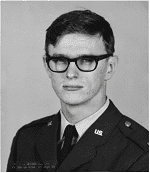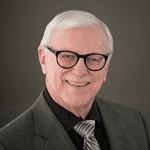George A. Fritsma, MS, MLS(ASCP)CM
 |
 |
| Lt. George Fritsma in 1970 and George Fritsma now. |
When I joined ASCLS—then the American Society for Medical Technology (ASMT)—in 1970, I was an Air Force first lieutenant directing a lab at Selfridge AFB north of Detroit. The annual convention was held at Cobo Hall (since demolished) in downtown Detroit, and it was the first convention I had ever attended. I found the exhibit hall but didn’t even know there were presentations in breakout rooms or hospitality suites.
In 1970 the Vietnam War had become a national disgrace, so to avoid disapproval I wore civilian clothes. I was the height of fashion in a green polyester suit with bell-bottoms and patent leather shoes. Selfridge’s commander learned that I had not worn my uniform and invited me to his office to “tear off a strip” when I returned. I subsequently wore my dress blues and drove the colonel’s staff car to the meeting.
When I separated from the Air Force in 1972, I attended an ASMT “lab tech” recruitment conference. While there I connected with my first civilian employer, Metropolitan Hospital in Detroit, associated with Highland Park Community College. Once in Detroit I became active in the Michigan Society for Medical Technology, serving as awards chair for a couple years.
Not every professional joins his or her association. Only 15 percent of practicing U.S. physicians join the American Medical Association. And of four million nurses, less than 200,000 join the American Nurses Association. Most health professionals are happy to meet the requirements of their positions with integrity, serving their patients well, and going home with a sense of professional satisfaction. We are not a nation of joiners, but we are happy to serve with competence.
So, who does join? Professional associations are the best sources for continuing education. Their workshops and seminars feature educators, thought leaders, and researchers working at the top of their profession. Associations blossomed when states began to mandate continuing education. Recently, however, we access electronic libraries and participate in inexpensive international webinars in the comfort of our home or workplace.
Wandering around the ASMT meeting in 1970, I noticed people seemed to spend their time chatting with colleagues, often while tipping a beer. I thought, “Not much going on here.” As I later found my own circle, I figured out these are people with responsibilities who relied on each other for information and support. Amidst many “superficial” conversations, we were learning new technologies, making personnel recommendations, and gaining professional insights.
As the years went on, through the Society I met many brilliant people; scientists, writers, and educators—each has been influential. And perhaps more importantly, every professional position I’ve held, every contribution I’ve made, and every opportunity that has come to me is a direct result of my involvement with ASCLS and the people I’ve met.
Garrison Keillor says that we join committees out of guilt. Some join just because we can’t say no. But most of us in ASCLS who have been around a few years participate as a means of giving back to our profession, from the gifts ASCLS continues to give us.
George Fritsma is proprietor of The Fritsma Factor, Your Interactive Hemostasis Resource, and lives near Birmingham, Alabama.
